- 45th Tokyo International Motor Show 2017 |
|
|
| Previous Tokyo International Motor Show review : - 2015 - 2011 - |
45th Tokyo Motor Show - The Japanese Automobile Market in 2016 |
This 45th Tokyo Motor Show is the occasion to discover the innovations and design creativity of the Japanese Automobile Manufacturers. Every brand has exhibited advanced technical projects and original design studies. The Tokyo Show is an opportunity to analyse the data proposed by the Japanese Automotive Manufacturers Association (JAMA).
In 2016 , Japan has 61,4 million automobiles in use as well as 14,4 million trucks and buses. The Japanese automobile manufacturers have produced 9,2 million motor vehicles in Japan and 18,9 million units in overseas plants for 2016.
Japanese Automobile Market in 2016
The 2016 motor vehicle sales in Japan totalled 4,97 million units with 4,1 million automobiles of which 1,3 million are mini cars or "keijidosha". The automobile "keijidosha" classification applys for vehicles with gasoline engine limited to 660 cc and overal car dimensions within 340 cm (11.2 ft.) lenght, 148 cm (4.9 ft) width and 200 cm (6.6 ft.) height. This category is very popular because of limited taxes, easy parking and low fuel consumption. Daihatsu, Honda and Suzuki are the specialists for this market.
Electric and Hybrid Vehicles Market share
When considering next generation vehicles with low emission propulsion system, it is interesting to discover that sales of hybrid vehicles account for 1,3 million units in 2016 and that is more than one out of five vehicles registered during that year. Hybrid automobile have been introduced by Toyota in 1997 with the Prius; it combines internal combustion engine and electric propulsion using a battery charged by energy recovery.
Electric vehicles have been introduced in 2009 with 1,078 vehicles registered that year compared to 15,299 vehicles in 2016. When all the battery electric car sales from 2009 to 2016 are considered we obtain 86,218 units potentially still in use, that is a very low figure for this zero emission segment.
The JAMA data show a total of 64,861 plug-in-hybrid vehicles sold between 2011 and 2016 and in particular 9,390 units sold in 2016. In plug-in-hybrid system, the battery is charged essentially on the electrical grid.
Hydrogen Fuel Cell Electric Vehicle Program
The Japanese MITI (Ministry of Trade and Industry) launched a development program for hydrogen and fuel cell propelled vehicles with an objective of 160 filling station and 40,000 vehicles in 2020. This 2020 target include utilization of hydrogen fuel cell vehicles, in particular buses, during Tokyo Olympic Games sheduled for 2020. Presently only Toyota and Honda are selling hydrogen fuel cell automobiles.
There are nearly 80 hydrogen filling stations in Japan today and we can account for 1473 hydrogen fuel cell vehicles in use today based on sales figure (2014-2016) in particular 1,055 units sold in 2016. |
| |
Overview of some exhibits |
| |
Toyota Fine Comfort Ride Hydrogen Fuel Cell Concept
|
Toyota City, Japan, October 18, 2017―Toyota Motor Corporation (Toyota) has launched the "Fine-Comfort Ride," a fuel cell vehicle (FCV) that envisions mobility in a low-carbon society with advanced utilization of hydrogen and renewable energy. The Fine-Comfort Ride proposes "a new form of the premium saloon" by employing a flexible layout unique to electric-powered vehicles and a large amount of available electric power using hydrogen as an energy source.
Toyota pursued further possibilities of FCVs through the development of the Fine-Comfort Ride. It offers excellent environmental performance by discharging no CO2 or substances of concern (SoC) while in operation, together with the convenience of a generous cruising range with a hydrogen refueling time of about three minutes. The characteristics of the Fine-Comfort Ride are as follows:
Exterior
- Adopts a diamond-shaped cabin that narrows towards the rear, while being wider in all dimensions from the front to the center of the vehicle, maximizing the space of the second row seats and aerodynamic performance.
- Utilizes a flexible layout unique to electric-powered vehicles, adopts an in-wheel motor, positions the wheels at the very corners of the vehicle, and utilizes a body underside cover, thereby achieving high running stability and quietness suited to a premium saloon.
Interior
- In adopting the concept of "wearing comfort (being wrapped in comfort)," the vehicle embodies future mobility that provides additional value other than movement to the passengers and is not simply just a "ride."
- The Agent function and the touch display are arranged around the driver and passenger seats. The seats allow for flexible adjustment according to posture, and the displays allow the driver and passengers to freely access information. The seat layout can be flexibly adjusted, so Fine-Comfort Ride can be used as individual space or as a communication space for individuals.
Performance
- The Fine-Comfort Ride boasts quietness and smooth running and also makes full use of the large amount of electricity provided by hydrogen as its energy source. The interior features a full range of equipment, and the car can achieve a cruising range of approximately 1,000 km (JC08 test cycle).
Main specifications
Vehicle Name |
Length |
Width |
Height |
Wheelbase |
Occupancy |
Fine-Comfort Ride |
4,830 mm |
1,950 mm |
1,650 mm |
3,450 mm |
6 |
| |
See related reviews inside :
|
|
|
|
|
|
 |
 |
 |
 |
 |
 |
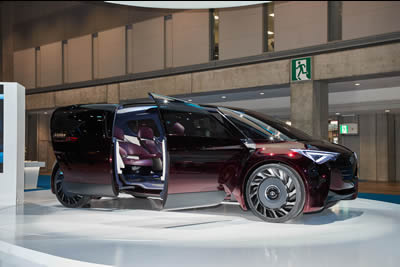 |
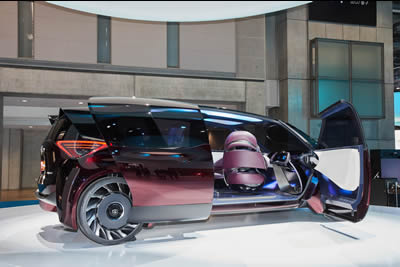 |
| |
Toyota FC Hydrogen Fuel Cell Bus Concept "SORA" |
Toyota City, Japan, October 18, 2017―Toyota Motor Corporation (Toyota) announces the launch of the "Sora1," a Toyota fuel cell bus (FC bus) concept. Toyota plans to launch sales of a commercial model based on the concept vehicle in 2018 and expects to introduce over 100 Sora, mainly within the Tokyo metropolitan area, ahead of the Tokyo 2020 Olympic and Paralympic Games.
Service vehicle for the entire community
Toyota aims to create a bus that works for the world and for people, is environmentally friendly, and can contribute to communities beyond its role as a mobility service.
- The Toyota Fuel Cell System (TFCS), which was developed for the Mirai fuel cell vehicle (FCV), has been adopted to deliver superior environmental performance with no CO2 emissions or Substances of Concern (SoC) emitted when in operation.
- The Sora is equipped with a high-capacity external power supply system, providing high output and a large capacity of electricity supply (9 kW maximum output, and electricity supply of 235 kWh2) and can be used as an emergency power source following disasters.
Universal design and function that is people-centered
Because the bus is envisioned to be used by large and varying numbers of passengers at any given time, Toyota paid close attention to convenience, safety, and peace of mind with the aim to give all passengers a pleasant riding experience, so that they would want to ride the buses regularly.
- Horizontal seats with an automatic storage mechanism improves comfort (first in Japan3)
The bus is equipped with horizontal seats with an automatic storage mechanism to provide space for strollers or wheelchairs. This provides extra seating for regular passengers when the space is not needed for strollers or wheelchairs.
- Improved safety from bus peripheral monitoring function (first in Japan3)
Eight high-definition cameras fitted inside and outside the vehicle detect pedestrians and bicycles around the bus, providing a peripheral monitoring function that warns the driver with sound and images to improve safety.
- Improved safety from acceleration control function (first in Japan3)
The acceleration control function suppresses sudden acceleration and enables gentle acceleration from stops, in consideration of the safety of standing passengers. Also, there is no lurching due to the lack of a need for gear shifting.
- Improved ease of boarding and exiting through automatic arrival control.
See related reviews inside :
|
 |
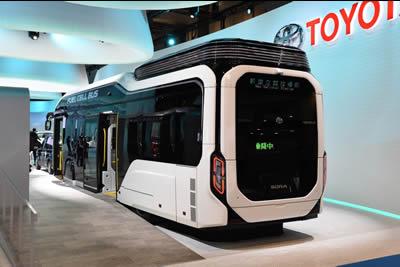 |
 |
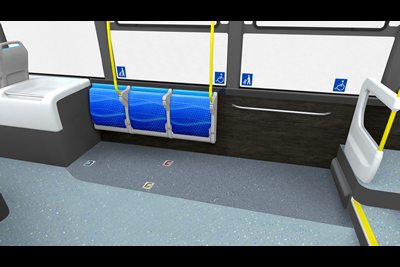 |
| |
Mitsubishi e EVOLUTION Electric SUV Concept |
The MITSUBISHI e-EVOLUTION CONCEPT is a technical prototype to illustrate the strategic directions of a renewed MMC Mitsubishi Motor Corporation brand, incorporating the strengths of the SUV and EV with the ability to integrate new systems for a connected mobility customer experience.
“We aim to provide vehicles that fulfill our customers' desires through outstanding design, combined with the power, authenticity and carefully-considered functionality MMC is known for,” said MMC Head of Global Design Tsunehiro Kunimoto.
The technologies of the MITSUBISHI e-EVOLUTION CONCEPT
- EV system: The MITSUBISHI e-EVOLUTION CONCEPT uses high-performance electric motors, fed by a high-capacity battery system, to deliver the smooth, torque-rich responsiveness that is the trademark of EVs compared to petrol-powered vehicles. The drive battery is located under the floor mid-ship of the vehicle, providing a low centre of gravity for improved driving stability.
- 4WD system: For exceptional driving performance, the triple motor 4WD system employs a single motor to drive the front wheels complemented by a new Dual-Motor Active Yaw Control (AYC) system that couples two rear motors through an electronically controlled torque-vectoring AYC unit. All of this is integrated into MMC’s unique Super All-Wheel Control (S-AWC) vehicle dynamic control system to greatly improve its cornering and traction performance. The brakes of the MITSUBISHI e-EVOLUTION CONCEPT responsively and precisely control the driving forces with the help of electric callipers that supersede conventional hydraulic brakes. The effects of the system can be felt and appreciated immediately, even at low speeds when G-forces are low. Whether driving around town, on motorways or winding roads, the fully electric vehicle always provides crisp and nimble handling that faithfully mirrors driver intent.
- AI system: The brain of the MITSUBISHI e-EVOLUTION CONCEPT is an Artificial Intelligence (AI) system that augments the driver’s capabilities. An array of sensors allows the AI system to instantly read changes in road and traffic conditions, as well as the driver’s intent. Seamlessly coordinating driver intent with vehicle performance, the system supports drivers of all abilities. By making it easier and safer to control the vehicle, the motoring experience is brought to a new level. A special coaching function allows the AI system to transfer knowledge to the driver and to unobtrusively enhance their driving expertise. After building a picture of the driver’s skill level, the system constructs a training program that provides advice through voice prompts and the large dashboard display. As a result, drivers of all abilities quickly experience a vehicle that behaves the way they want it, and soon they find themselves enjoying the driving experience to an even greater degree.
|
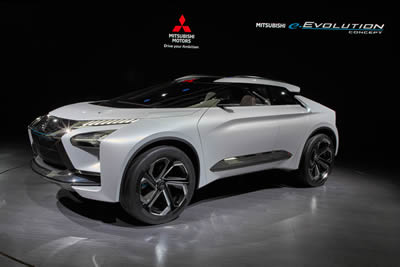 |
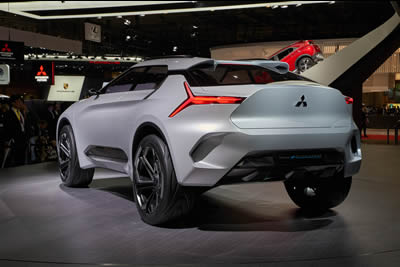 |
 |
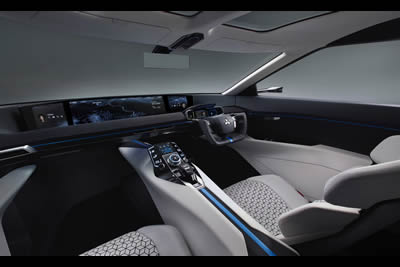 |
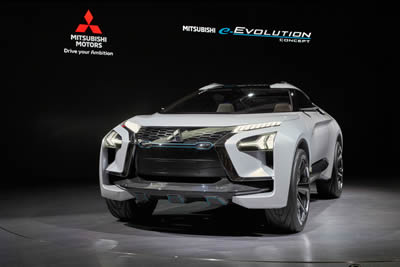 |
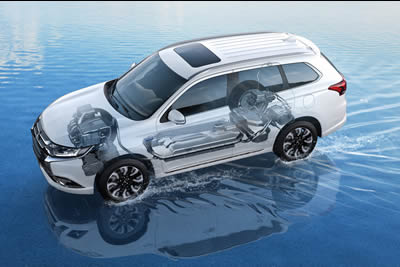 |
| |
Toyota Concept i |
TOYOTA Concept-i is a four-wheel model representing the TOYOTA Concept-i series that embodies the future vision of a mobility society. The concept made a world premiere at 2017 Consumer Electronic Show in Las Vegas earlier this year.
The core technology common to the TOYOTA Concept-i series is a technology that understands people (LEARN), applying AI (artificial intelligence) to recognize emotions and estimate driver preferences.
The technology that understands people (LEARN) and automated driving technology combine to lead the driver to safety and provide peace of mind (PROTECT).
In addition, by combining the technology with the agent technology, it will be possible to advance technology to the point that the driver's feelings can be anticipated, leading to new Fun to Drive experiences (INSPIRE).
See related reviews inside : Toyota Concept i 2017 and Dr. Pratt remarks on autonomous mobility |
 |
 |
 |
 |
 |
 |
| |
Toyota Concept i RIDE |
TOYOTA Concept-i RIDE is a small mobility vehicle that emphasizes universality based on the concept of user-friendly city mobility.
It features gull-wing doors, an electric universal sliding seat, and a joystick, achieving user-friendly operation for wheelchair users.
In addition, the seat layout and automated driving functions make it possible for anyone to drive safely and securely.
Moreover, use with sharing services is also envisioned. By sharing with more people, universal mobility is made easier to use.
|
 |
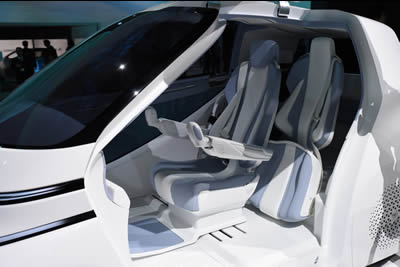 |
 |
 |
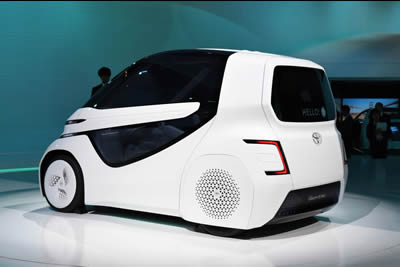 |
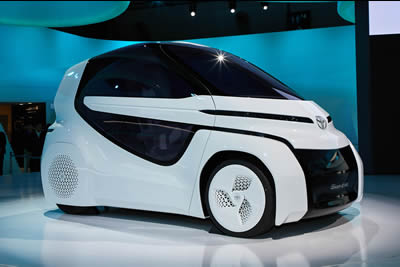 |
| |
Mazda VISION Concept
|
Since 2010, Mazda has attracted global acclaim for its vital and dynamic car designs created under the KODO—Soul of Motion philosophy.
The Mazda VISION COUPE is next-generation design vision model with four doors.
The exterior of the next-generation vision model embodies a minimalist Japanese aesthetic, achieving a simple “one motion” form that exudes a sense of speed. No details has been provided considering the power train. The styling clearly recalls the two doors coupe Mazda RX-Vision exhibited in 2016 with a claim for the return of the rotary engine.
|
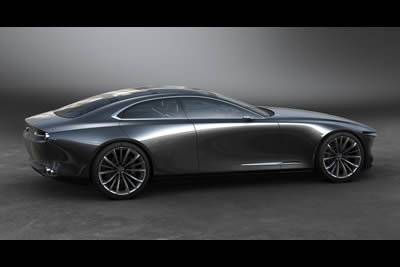 |
 |
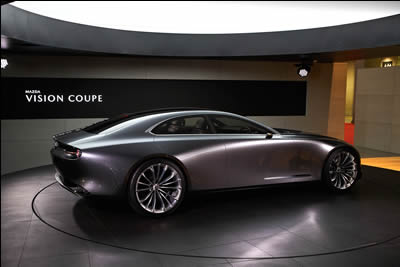 |
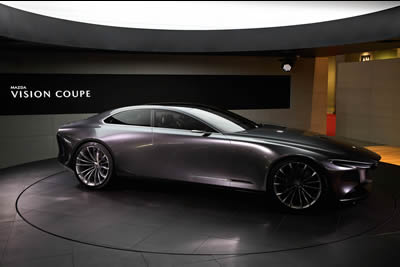 |
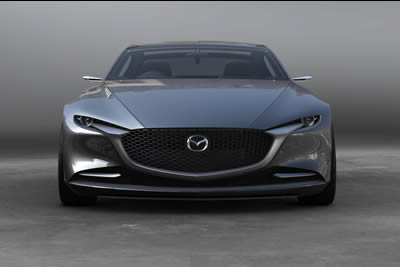 |
 |
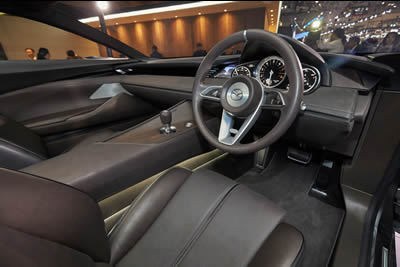 |
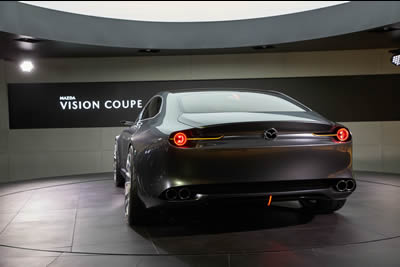 |
| |
Mercedes AMG Project One Prototype |
The Mercedes AMG Project One made its world premiere at the 2017 Frankfurt Motor Show. It uses Formula One hybrid technologies adapted for road use. 275 units are scheduled for production.
See related reviews inside : Mercedes AMG Project One Prototype |
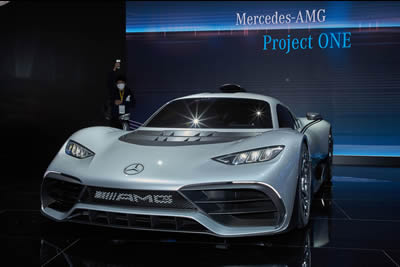 |
 |
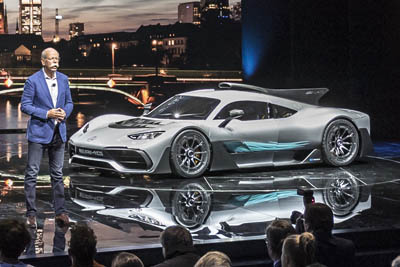 |
 |
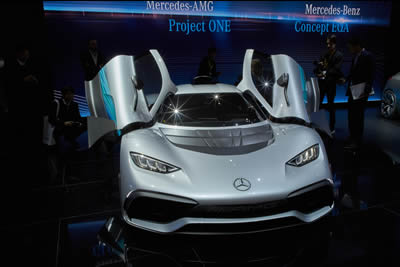 |
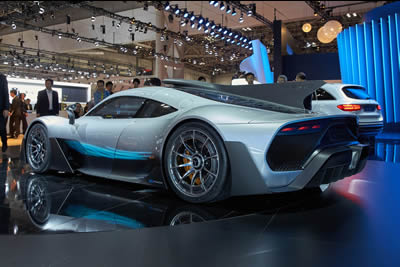 |
| |
Nissan IMx Electric and Autonomous Concept |
|
YOKOHAMA, Japan (Oct. 25, 2017) – The Nissan IMx, an all-electric crossover concept vehicle offering fully autonomous operation and a driving range of more than 600 kilometres (373miles), was unveiled at the Tokyo Motor Show.
“The IMx zero-emission crossover concept vehicle embodies the future of Nissan Intelligent Mobility,” said Daniele Schillaci, executive vice president for global marketing and sales, zero-emission vehicles and the battery business. “Through Nissan Intelligent Mobility, Nissan is committed to changing the way people and cars communicate, as well as how cars interact with society in the near future and beyond.”
At the core of the IMx’s technological features is a future version of ProPILOT that offers fully autonomous operation. When ProPILOT drive mode is selected, the system stows the steering wheel inside the dashboard and reclines all seats, giving the driver more space and allowing the vehicle’s occupants to relax and enjoy their commute. When Manual drive mode is selected, the vehicle returns the steering wheel and seats to their original position, seamlessly transferring control back to the driver.
The Nissan IMx concept vehicle adopts Nissan’s new EV platform, designed for maximum efficiency. It allows the floor to be completely flat, resulting in a cavernous cabin and enhanced driving dynamics. With a low center of gravity, the chassis delivers sharp handling that promises to redefine the crossover segment.
The powerful yet quiet powertrain delivers enhanced excitement. The IMx is propelled by a pair of high-output electric motors at the front and rear, giving it all-wheel-drive capability. They combine to produce 320 kW of power and an astounding 700 Nm of torque, sourced from a high-capacity battery which has been redesigned and re-engineered for increased energy density. This new battery supports a driving range of more than 600 kilometres on a single charge, so occupants can enjoy an extended adventure without worrying about recharging.
The Nissan IMx can also contribute to the social infrastructure like no other vehicle before it. For example, after transporting its owner to the airport, the IMx can park itself in a spot where the vehicle can connect to the local power grid and act as a “virtual” power plant by returning electricity to the grid, an extension of its vehicle-to-home and vehicle-to-building features. Once the owner returns, the IMx can pick them up at the terminal and drive home. The whole process is carried out efficiently, thanks in part to the increased battery capacity and connected-car technologies, including Seamless Autonomous Mobility. |
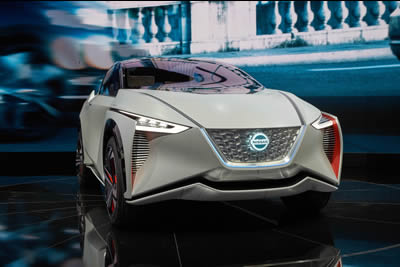 |
 |
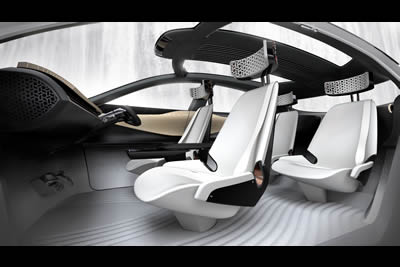 |
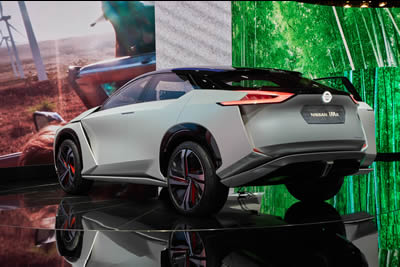 |
| |
Mitsubishi KAI Concept and SKYACTIV-X engine |
Featuring the next-generation SKYACTIV-X gasoline engine, SKYACTIV-Vehicle Architecture and a more mature expression of the KODO design language, the Mazda KAI CONCEPT embodies the technology, engineering and design concepts that will define the next generation of Mazda cars. Refinements in all areas of dynamic performance have produced a dramatically quieter, more comfortable ride and an enhanced performance feel. The KAI CONCEPT features muscular, solid proportions and its form is brought to life by a delicate flow of reflections over the body sides.
SKYACTIV-X is an entirely new internal combustion engine from Mazda that combines the high-revving character of a gasoline engine with the fuel efficiency, torque and fast initial response of a diesel. With its proprietary combustion method called Spark Controlled Compression Ignition (SPCCI), SKYACTIV-X is set to become the world’s first commercial gasoline engine to use compression ignition. SPCCI overcomes the long-standing issue of maximizing the zone in which compression ignition is possible and realizes a seamless transition between compression ignition and spark ignition. |
 |
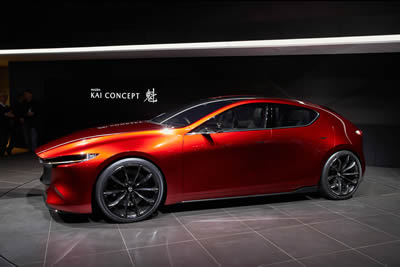 |
 |
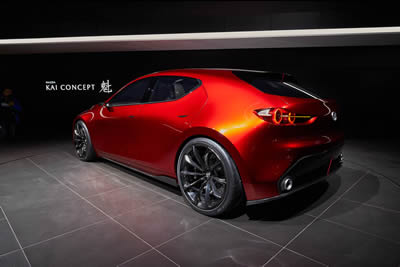 |
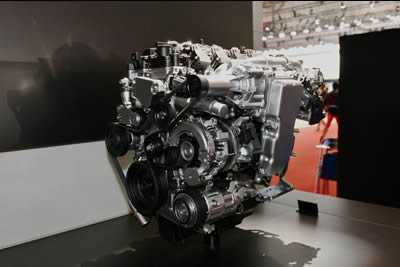 |
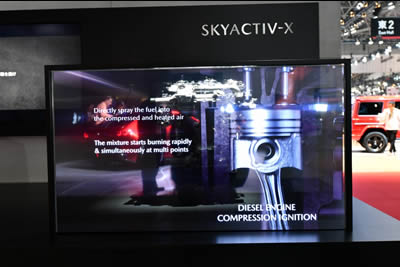 |
| |
Subaru Viziv Performance Design Study |
“SUBARU VIZIV PERFORMANCE CONCEPT” is conceptual models of SUBARU's future vision of high performance vehicles. Its lower center of gravity, solid bodywork with aggressiveness, and form of pendent fender with dynamics - the evolving energy from the very first moment of driving is expressed by the SUBARU's philosophy of design, “DYNAMIC×SOLID”. This model has realized high performance by the Horizontally-Opposed engine and the symmetrical AWD, introducing self-driving technology based on the high performance EyeSight. We combine driving performance and high safeness at higher level aiming for precluding accident, and provide our value, “Anytime, anywhere, the driver will enjoy driving in peace of mind , in our own way. |
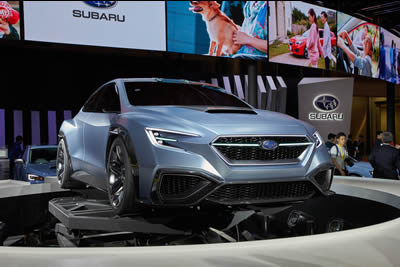 |
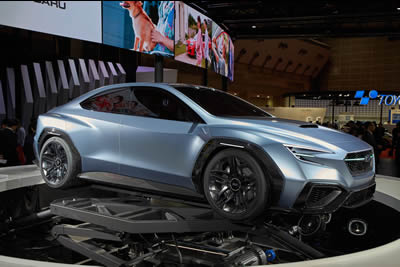 |
 |
 |
 |
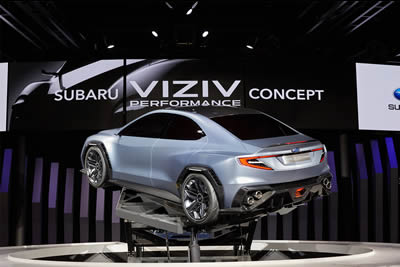 |
| |
Nissan Leaf NISMO Concept |
The NISMO Concept version of the new LEAF has a sporty exterior. The application of NISMO racing technology to the car’s body results in enhanced aerodynamic performance and less lift, without sacrificing the LEAF’s excellent drag coefficient. The black interior features NISMO’s signature red accents, creating an exciting, high-performance feel.
Nissan announced at the same time that it will become the first Japanese automotive brand to compete in the all-electric FIA Formula E racing in 2018/19.
“As the ultimate expression of the thrill of instant acceleration and agile handling that’s at the heart of Nissan zero-emission driving, Nissan is going to electrify the Formula E championship,” said Daniele Schillaci, executive vice president of global marketing and sales, EV business, and chairman of Nissan’s management committee for Japan, Asia and Oceania.
Nissan will enter the series from late in 2018, when the all-electric championship will introduce new chassis and battery regulations.
|
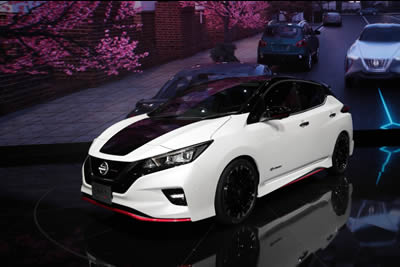 |
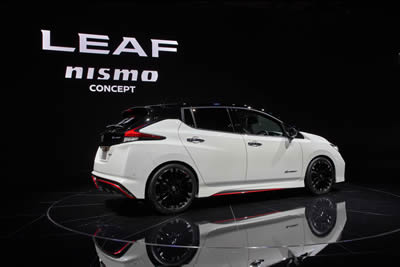 |
|
| |
AUDI Q8 Sports Plug-in-Hybrid Concept |
The Audi Q8 sport concept study demonstrates the vision Audi’s developers and designers have for the dynamic yet efficient SUV of tomorrow.
Characteristic aerodynamic features in the front and rear are a prominent part of the Audi Q8 sport concept design. The highly efficient drive system concept of the study is particularly groundbreaking. The 3.0 TFSI six-cylinder engine featuring a mild hybrid system and an electric powered compressor is a world first. The result: the Q8 sport concept presents itself as a multi-disciplined athlete with a number of talents. Thanks to its 350 kW (476 hp) output and its 700 Newton meters (516.3 lb-ft) of torque, it sprints from 0 - 100 km/h (0 ‑ 62.1 mph) in just 4.7 seconds and keeps going until it reaches its top speed of 275 km/h (170.9 mph). Meanwhile, its range of more than 1,200 kilometers (745.6 mi) ensures it is also suitable for long journeys.
Thanks to the superb recuperation performance of 20 kW, this prominent SUV holds back when it comes to fuel consumption. Compared with a model equipped with a regular TFSI six-cylinder engine without mHEV system, the Q8 sport concept with its 20 kW greater performance consumes around one liter less fuel per 100 km – that corresponds to a reduction in CO2 emissions of 25 g/km (40.2 g/mi).
“The drive system of the Audi Q8 sport concept is a major step towards optimizing efficiency and sustainability in large-volume series production. The combination of mild hybrid technology and a TFSI engine sets a new benchmark for the synthesis of electromobility and combustion engines. In the future, this combination will be used in many Audi models,” says Rupert Stadler, Chairman of the Board of Management at AUDI AG. |
 |
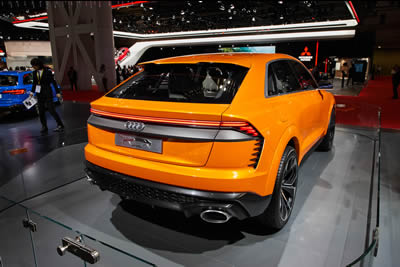 |
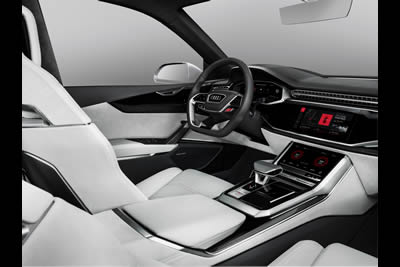 |
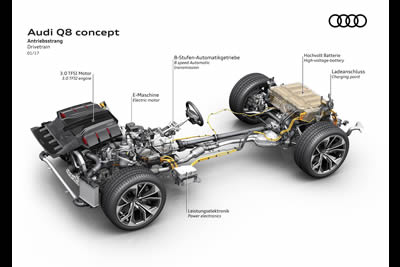 |
| |
Honda Sports EV Concept |
Honda exhibited the world premiere of the Honda Sports EV Concept, a concept model which combines EV performance and AI (artificial intelligence) inside a compact body with the aim to realise the joy of driving the user can feel with a sense of unity with the car. |
 |
 |
 |
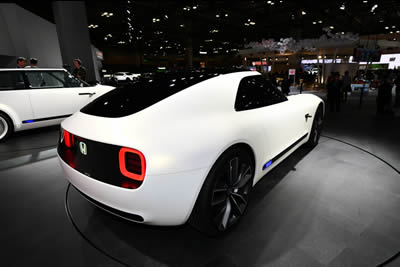 |
| |
Honda NeuV Concept |
The Honda NeuV is an EV concept model that explores the potential of mobility products which will be further expanded by automated driving technologies and AI. This concept has previously been exhibited at 2017 Consumer Electronics Show in Las Vegas or at 2017 Geneva Motor Show.
The Honda NeuV makes judgments about the driver’s state of stress based on facial expressions and/or tone of voice and provides assistance to the driver to support safe driving, and by learning the driver’s lifestyle and preferences, provides suggestions to the particular driver, realising communication between driver and mobility. |
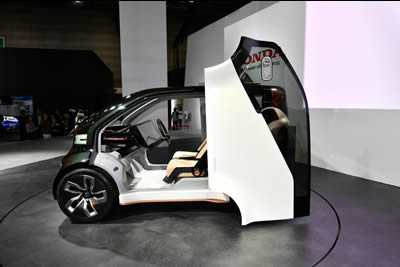 |
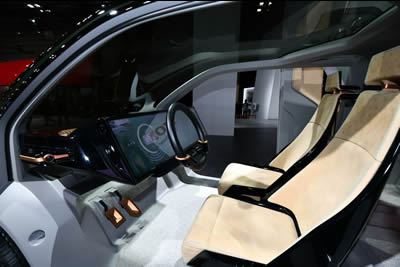 |
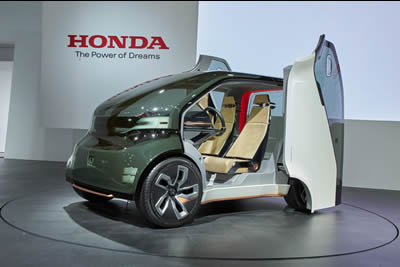 |
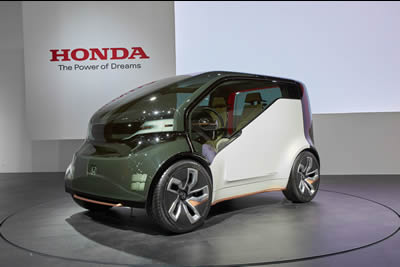 |
| |
Honda Urban EV Concept |
Built upon a newly developed EV-only platform, the Honda Urban EV Concept is a compact car, ideal for urban driving. The exterior expresses Honda’s small car DNA, the “joy of lively driving” and “friendliness that inspires attachment” simply and iconically. The front and rear are equipped with displays that show messages and greetings to onlookers. The living room-like interior is modern and comfortable, equipped with a large display and “Honda Automated Network Assistant” based on Honda’s AI technology. Learning the driver’s lifestyle and tastes, the Honda Urban EV Concept provides the driver with timely suggestions, realizing a natural communication between driver and car. A small car that is closer to people, closer to life: this is Honda’s vision of the new relationship between people and cars.
.Honda announced that a new model based on this concept will go on sale first in Europe, and then in Japan in 2020. |
 |
 |
| |
Daihatsu DN Compagno |
The Daihatsu DN Compagno is a four-door coupe targeted at active seniors.
Stylishly designed, the vehicle comfortably seats two adults and provides colorful support to post-retirement lives.
- With its beautifully unconstrained shooting lines, the DN COMPAGNO inherits the compact, stylish approach to design of the original Compagno, which launched in 1963
- The vehicle prioritizes the relaxing comfort of the two front seats, which it combines with a sporty and high-quality interior
- The DN COMPAGNO features a 1,000 cc turbo powertrain, with the option of a 1,200 cc hybrid
|
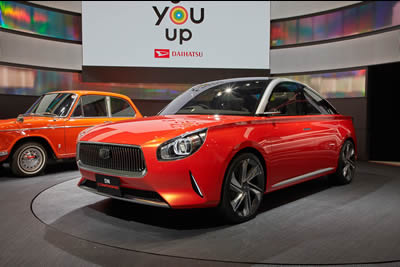 |
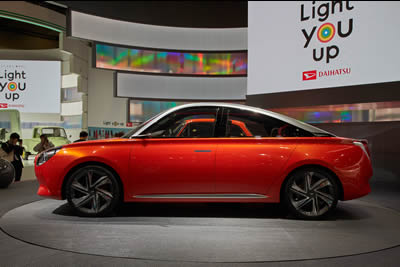 |
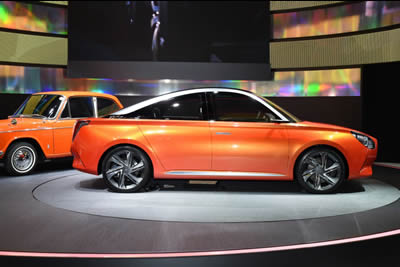 |
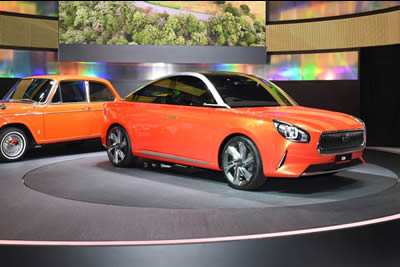 |
| |
Daihatsu DN U Space
The Daihatsu DN U Space is an all-new proposal, more spacious mini vehicle with superior ease-of-use to support busy mothers
- The DN U-SPACE features a simple yet modern interior and exterior design
- The vehicle incorporates a host of features that provide outstanding convenience: large, pillar-in sliding front and rear doors with hands-free opening and closing functions, interior walk-through enabled by a tip-up front passenger seat, and panoramic front-seat views
- The vehicle features a 660 cc gasoline engine powertrain |
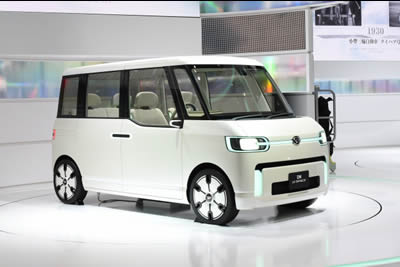 |
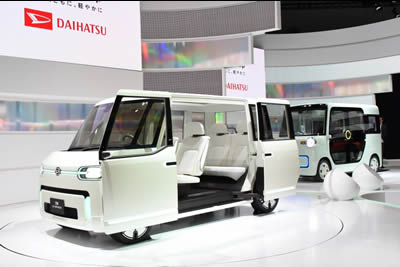 |
| |
Daihatsu DN Pro Cargo and DN Multisix |
|
The Daihatsu DN Pro Cargo is a commercial EV that pursues the innate convenience of mini vehicles to its limits.
Easy to use for both women and seniors, its low, flat floor results in a vast interior space, while its luggage space is exceptionally convenient.
- The DN PRO CARGO inherits the outstanding ease-of-use of the Midget which was utilized in a wide range of industries following its launch in 1957.
- The vehicle’s low, flat floor makes for easy ingress and egress for both women and seniors, while the ability to walk through its vast, 1,600 mm-tall interior provides superb work and service utility
- The vehicle features a highly customizable multi-unit system that can be changed to suit a wide range of industries and uses. |
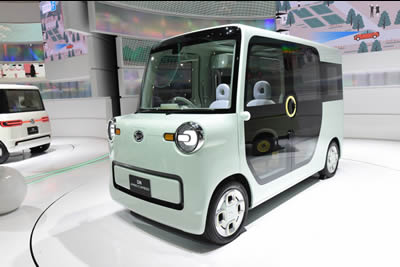 |
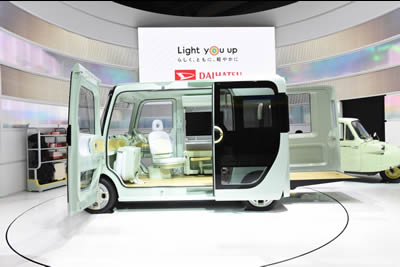 |
The Daihatsu DN Multisix ( pictures below ) is a stylish, premium six-seater minivan in a compact form
- A compact minivan with three rows of seating, it combines ease-of-use with a sense of luxury
- The second row of seats features an aisle space that can be walked through, so improving the utility of the third row of seats
- The vehicle features a 1,500 cc gasoline engine |
 |
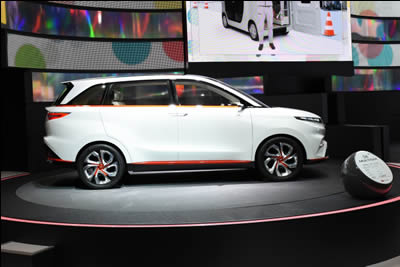 |
| |
Toyota TS050 LMP1-Hybrid Endurance Racing Car |
The 2017 LMP1 Hybrid racing car features a 2.4litre V6 turbo-charged petrol engine combined with 8MJ hybrid system. Significant effort at Higashi-Fuji sees the introduction of a new engine, optimising thermal efficiency by increasing the compression ratio via development of the combustion chamber, cylinder block and cylinder head.
The 2017 TS50 LMP1-Hybrid Toyota, this WEC season, gained victory at Silverstone 6 Hours, Spa Francorchamps 6 Hours and lately Fuji 6 Hours.
related article : TS050 Hybrid LMP1 2017 |
 |
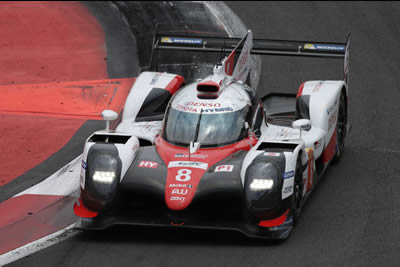 |
| |
Toyota GR HV Sports Concept |
The GR HV SPORTS concept represents a new way to enjoy cars by integrating the thrill of a sports car with the environmental friendliness of an eco-car. Switching to manual mode is possible with the single press of a button, and 6-speed manual-style driving with H-pattern shifting can be enjoyed. Also, features a targa top that was also used for Toyota’s legendary convertible sports cars. You can enjoy both the thrill of a sports car and the open air fellling by the targa top.
Main Features
- The design is reminiscent of TOYOTA GAZOO Racing's TS050 Hybrid racing car that competes in the World Endurance Championship (WEC).
- Features a targa top that was also used for Toyota's legendary convertible sports cars, the Toyota Sports 800 (a.k.a. Yotahachi) and the Supra
- Powered by THS-R (Toyota Hybrid System-Racing) that is infused with hybrid technology refined by the TS050 Hybrid
Design
- While completely embodying functionality as a genuine sports car, the GR HV SPORTS concept features LED headlights, aluminum wheels, and a rear diffuser similar to the TS050 Hybrid. The design evokes Toyota's bond with motor sports.
- The matte black body color expresses power and aggressiveness.
Interior
- A selection switch to choose the automatic gear position is located in the center cluster to achieve a racing car-like ambience.
- The push button ignition switch is playfully located on the shift knob.
|
 |
 |
 |
 |
| |
Lexus LS+ Automated Driving Concept |
Toyota City, Japan (October 25, 2017)―Lexus premiered to the world today its automated-driving-capable "LS+ Concept" concept vehicle at the 45th Tokyo Motor Show 2017.
Aiming to contribute to achievement of a world free of traffic casualties, Lexus has been actively introducing advanced technologies based on its Integrated Safety Management Concept. It aims for application in the first half of the 2020s of its "Urban Teammate" technologies for automated driving on regular roads.
The LS+ Concept, equipped with state-of-the-art technologies, indicates the future image of the "LS" flagship sedan. With its advanced yet dignified styling and automated driving technologies planned for application in 2020, the LS+ Concept was developed as a model that symbolizes Lexus' vision.
Advanced yet dignified styling representing the future image of the "LS" flagship sedan
- As a concept vehicle that suggests the future look of the LS, the LS+ Concept produces a dignified expression as a flagship and indicates the direction of next-generation Lexus design based on Lexus' L-finesse*3 design philosophy. In addition to a boldly evolved Spindle Grille, with a large grille shutter that contributes to both improved cooling and enhanced aerodynamic performance, distinctive Lexus vision is expressed in the LS+ Concept through, among others, partly laser-lit headlamps and rear combination lamps, as well as through electronic side mirrors.
Latest automated driving technologies
- Lexus is pursuing a world in which all people can enjoy safe, smooth and untethered mobility through automated driving technologies. Specifically, it intends to make automated driving from entrance ramp to exit ramp on motor-vehicle-only roadways possible by using its "Highway Teammate" automated driving technologies, which, with an eye toward application in 2020, are featured on the LS+ Concept. On motor-vehicle-only roadways, through appropriate recognition, judgment and operation by onboard systems in response to actual traffic conditions, these technologies can enable automated merging, lane changes and diverging, as well as keep a vehicle in its lane and maintain vehicle-to-vehicle distance.
- The LS+ Concept can communicate with a data center to update its systems' software, allowing new functions to be added. Meanwhile, AI that learns from big data, including information on roads and surrounding areas, ensures a high level of automated driving. The car, which can learn and grow along with its users, represents a new age for the image of cars to which people can become emotionally attached.
|
 |
 |
 |
 |
| |
Toyota Century Third Generation |
The new 3rd generation Century carries on the tradition of master craftsmanship and high-quality monozukuri (all-encompassing manufacturing) while realizing high-demand environmental performance and a design layout that pursues passenger comfort. The interior and exterior design injects new charm into the Century in line with its heritage.
Moreover, the new Century features advanced equipment and comfort amenities only suitable for a luxury limousine.
Specifically, the Century is now powered by a 5.0-liter V8 hybrid system for outstanding fuel efficiency.
In addition, the wheelbase has lengthened, the height difference between the scuff plate and floor has decreased, and the height of the door opening has increased, all of which are refinements improving the rear seat riding experience. The intricately glamorous and chic exterior is highlighted by traditional Japanese design elements used throughout the car including the grille and black trim on the rear combination lamps. The interior features a raised ceiling*1 design and exclusive fabric while the adjustable rear seats (with massage function), are upgraded with a power leg rest for first-class comfort and a sophisticated riding experience.
*1The raised ceiling is an architectural ceiling design with additional height in the center area.
Interior design
- A raised ceiling and the application of a traditional pattern befitting a vehicle of the highest class
- In the rear seat area, heather-patterned upholstery is applied from the backs of the front seats to the door panel trim, emphasizing horizontal space. The seat upholstery is made of high-quality materials, including 100% wool that is extremely flexible and soft. Models with leather interiors offer high-end, soft-textured upholstery.
- Similar to the rear seat area, the front seats utilize horizontal heather-patterned upholstery that emphasizes space. The black heather-patterned decoration in the center of the instrument panel expresses a noble and sophisticated interior.
- The step-less, adjustable power leg rest and adjustable rear seats (with a massage function) ensure a comfortable ride.
- A multi-operational LCD panel located in the central armrest enables passenger control of all seats, air conditioning, and audio controls.
- Equipped with furnishings that can be used for business or pleasure such as a writing table, reading light, rear seat entertainment system with a large-sized display, and a 20-speaker premium audio system.
Basic Performances
- In addition to a specially-tuned suspension and high rigidity body, both driving stability and premium ride comfort are realized by the use of newly developed tires specialized for ride comfort and reduced road vibration.
- Optimization of the engine mount and the active noise control system reduces noise and vibration when the engine starts and achieves smooth acceleration and overwhelming serenity in the cabin.
- The 5.0-liter 2UR-FSE V8 engine using "D-4S*2" direct injection technology for low fuel consumption and high output is installed in combination with hybrid system (THS II*3) in pursuit of the lowest fuel consumption in its class. In addition, a two-stage motor speed reduction device realizes quiet and smooth driving.
- Safety features suitable for a limousine such as Toyota Safety Sense P collision avoidance support, blind spot monitoring, and rear cross traffic alert are adopted.
|
 |
 |
 |
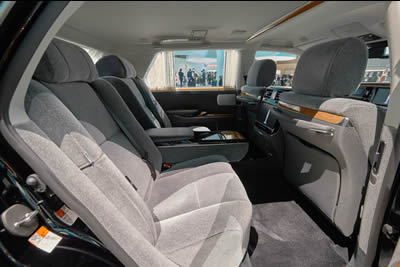 |
| |
|
Toyota JPN LPG Hybrid Taxi |
Toyota City, Japan, October 23, 2017―Toyota Motor Corporation (Toyota) launched a new taxi vehicle, the "JPN Taxi." The new model became available today at Toyota and Toyopet dealers nationwide.
The JPN Taxi embodies the spirit of Japanese hospitality. It was developed to provide usability and comfort to a wide range of people, including children, seniors, wheelchair users, and visitors to Japan from abroad. Toyota aims to change Japan's landscape, develop barrier-free cities, and transform Japan into a tourist-oriented country by promoting the widespread use of its JPN Taxis.
The new model showcases a people-friendly, universal design that provides usability and comfort to a wide range of people through continual innovations and improvements, from grab handles to the overall vehicle structure. Design features include a low, flat floor, making it easy for customers to ingress and egress from the taxi, a wide-opening, power rear sliding door (left side only) and space to accommodate wheelchair users.
Furthermore, this model offers the driver an optimal range of vision, in part through innovations to the position and shape of the pillars and the use of fender mirrors. As a design priority for this taxi model, functionality was improved by positioning the dashboard instruments and other devices in the taxi to allow easy access, including the placement of the GPS system and taxi meter in a spot that is easy for customers to see.
Environmental performance and power performance were both taken to new levels. By employing a newly developed liquefied petroleum gas (LPG) hybrid system, the new model offers 19.4 km/L4 fuel economy and sharply reduced CO2 emissions. Enhancements were made to safety equipment, including adding the Toyota Safety Sense C package and six SRS airbags as standard features.
Toyota began its venture into the taxi industry in Japan in 1936 with the introduction of the Toyota Model AA. In 1953, Toyota released the Toyopet Super RH model and other vehicles, which have become fixtures helping transport many people over the years. Toyota taxis have and will continue to travel greater distances than the average vehicle and be used in the toughest road conditions. This could be considered the starting point for automobiles that pursue a vision of ideal automotive development. |
|
| |
BMW Z4 Concept |
|
| |
Daihatsu DN TREC
The Daihatsu DN TREC is a compact, stylish SUV suitable for both daily use and hobbies
- The DN TREC boasts a high-quality, compact interior and exterior styling, which embody the themes of “active, fun and tough”
- An active vehicle, it is suitable for daily use and hobbies
- The vehicle features a 1,200 cc hybrid powertrain, with the option of a 1,000 cc turbo |
|
| |
ISUZU FD-SI Design Concept
With the concept of "future delivery", Isuzu Motors Limited reviewed the delivery networks from a new perspective to express how exciting the future delivery could be.
Isuzu Motors Ltd focused its attention on the "group intelligence" found in insect's activities, and applied it to the collection and delivery method.
The exterior is a honeycomb-like design. The cargo space is also structured like a honeycomb featuring a good compromise between strength and space needed for storage. As the packing style of the cargo, the hexagonal boxes to be piled up have been adopted.
In the cabin, the controllers are gathered in the center of the instrument panel, and the steering wheel is retractable. The seat is placed in the center to enable the driver to move smoothly, achieving high operability and comfortable living space.
|
|
| |
Suzuki e-SURVIVOR Concept |
•The e-SURVIVOR is a compact SUV of the next age, which inherits the magnetic identity of Suzuki from the Jimny and the Vitara.
•While keeping our renowned drivability made possible by the ladder frame and lightweight compact body, it offers new possibilities of an electric four-wheel-drive |
| |
| |
Suzuki Spacia Concept |
The SPACIA CONCEPT is a concept model of the Spacia, a user-friendly tall miniwagon with low floor, spacious cabin, and rear sliding doors on both sides.
•It is a new tall miniwagon that offers a sense of excitement and fun from daily to weekend driving with families and friends.
|
 |
 |
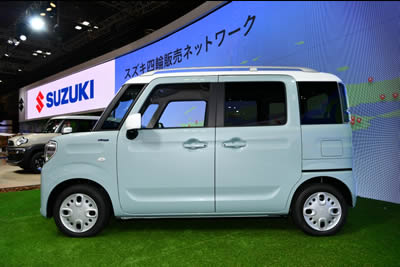 |
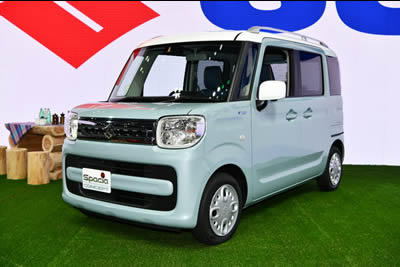 |
|
| |
Suzuki XBee Outdoor Adventure and XBee Street Adventure Concept |
The Suzuki XBEE is a compact crossover wagon that fits in various lifestyles; from stylish lifestyle in the city to active leisure in nature.
•This new genre of compact crossover wagon combines wagon packaging of spacious cabin that exceeds its class in a manoeuvrable compact size with a rough-road drivability and functionality of an SUV, and embellishes it with distinctive, unforgettable styling design that has strength and toughness of an SUV.
The Suzuki XBEE STREET ADVENTURE heightens the crossover wagon XBEE’s attractiveness of fitting into the urban scenes.
Intended for fashionable and active urban lifestyles, this new variant infuses fun and appeals with the distinctiveness of the XBEE, and nicely fits in the city.
The Suzuki XBEE OUTDOOR ADVENTURE heightens the crossover wagon XBEE’s attractiveness of fitting into outdoor scenes.
•As a variant of the XBEE designed for grownups who love camping, the elegant and attractive presence blends into the nature well and offers fun of using it in the outdoors. |
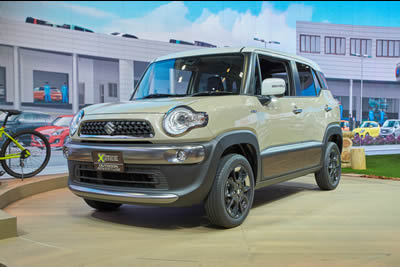 |
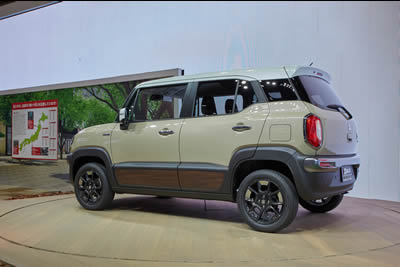 |
| Suzuki XBee Outdoor Adventure Concept |
 |
 |
| Suzuki XBee Street Adventure |
|
| |
Suzuki Carry Open-Air Market Concept |
•The Suzuki Carry Open-Air Market Concept is designed as a mobile shop truck at an open-air minitruck market with enhanced cabin space and user-friendliness.
•It goes beyond being just a commercial car and offers wide possibilities from daily transportation to leisure.
•In addition, it incorporates features that are on everyone’s wish list.
|
| |
| |
Yamaha Cross Hub Concept |
This vehicle is aimed at connecting the “active” and “urban” in the lifestyles of Yamaha enthusiasts. It has a unique diamond-shaped seating layout for the cabin that enables a compact vehicle package but also the capacity to carry up to two motorcycles in the rear, making it a design concept model that takes occupants straight into the world of Yamaha recreation. DimensionsL:4,490xW:1,960xH:1,750mm |
| |
| |
Toyota Tj Cruiser Concept |
The Toyota Tj CRUISER was designed for drivers with lifestyles where work and play dovetail seamlessly. The "T" in Tj CRUISER stands for "Toolbox" in reference to how the car can be used like a toolbox, while the "j" stands for "joy" in reference to the joy of visiting various places by car. The name "CRUISER," which is traditionally used for Toyota's SUV lineup, is assigned to the Tj CRUISER to express the power of the vehicle. Inside, the passenger seat can be reclined completely flat, and not only can the Tj CRUISER easily hold outdoor equipment, it can also store large items such as 3-meter long surfboards and bikes.
Design
- The square-shaped cabin, similar to that of a van, exudes high utility. Meanwhile, the sturdy suspension realized by large SUV-sized tires is fused with a bold front. The Tj CRUISER symbolizes a new genre incorporating the strengths of a van with those of an SUV.
- The hood, roof, and fenders use materials (with special coating) that resist scratches and dirt, even when objects accidentally come into contact with them.
Interior Space
- The front and rear passenger seats can be reclined completely flat for storing long items up to 3 meters in length such as surfboards.
- The backs of the seats and deck boards include numerous tie-down points to enable easy anchoring of items from small packages to longer objects. Moreover, the large opening of the back door makes for easy loading and unloading of large items such as bikes.
- The seat cushion on the passenger seat directly behind the driver can be flipped up towards the front to create dedicated space for storing groceries or shopping items.
- The large openings of the sliding doors enable loading and unloading of large items from the sides and easy entry and exit for family members, as well.
Other Features
- Use of the next-generation TNGA platform expected
- The unit to run on a 2.0-liter class engine + hybrid system
- Front-wheel-drive, four-wheel-drive system to be used
Main Specifications
Name |
Length
(mm) |
Width
(mm) |
Height
(mm) |
Wheelbase
(mm) |
Seating
(occupants) |
Tj CRUISER |
4,300 |
1,775 |
1,620 |
2,750 |
4 |
|
| |
| |
Toyota Auto Body LC D-Cargo Concept |
Toyota Auto Body (TAB), the subsidiary of Toyota Motor Corporation in charge of the production of vehicle bodywork and bespoke body engineering, has exhibited the (Light Commercial Vehicle) LCV concept – which is designed to be a flexible vehicle that can accommodate the user’s needs, be it work or leisure.
The LCV is designed to be compact and adaptable to carry passengers in comfort and style or be made to offer economical and durable goods carrying capacity. |
| |
|
| |
Zagato VISION Iso Rivolta Gran Turismo |
| |
| |
Ikeya Formula IF-02RDS one-off Prototype |
| |
| |
Yamaha MWC-4 Concept |
The Yamaha MWC-4 is a compact four-wheeled vehicle that is able to offer the feeling of stability from having four wheels, but with a motorcycle’s unique fun and appeal of being one with your machine, resulting in an enticing new feel thanks to Yamaha’s exclusive Leaning Multi-Wheel (LMW) * technology.
*LMW is Yamaha’s designation for vehicles with three or more wheels that can lean like a motorcycle through turns.
Looking to expand upon the possibilities for personal mobility stemming from motorcycles, this Leaning Multi-Wheel (LMW) vehicle has two wheels front and rear and was developed under the concept of “Half-Sized Mobility.” The MWC-4 is powered by electric motors and a gasoline engine for range-extending power generation, and uses attitude-control technology, giving it a ride that feels like nothing else and a level of comfort not found with a conventional motorcycle. This is all expressed with styling inspired by the features of both motorcycles and musical instruments. |
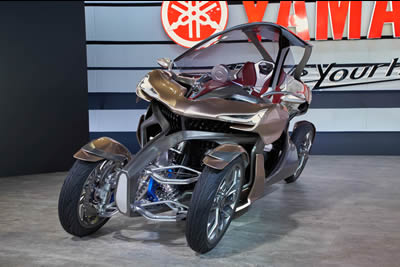 |
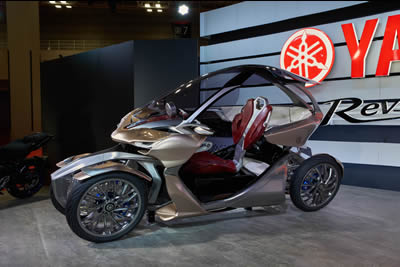 |
|
| |
Volkswagen I.D. BUZZ Electric Concept |
From 2020 on VW is planning to introduce the new EV-series “I.D.”. The “I.D. BUZZ” is one of the line-up models, making the microbus concept real. The design closely resembles to the Volkswagen Type 2 which has born many fans and subcultures mainly in Europe and the U.S. in the 60s and 70s. The driving system, which is using 2 electric motors, is creating a system power of 275kW, and the lithium-ion battery below the floor is enabling the vehicle to drive up to 600 km.
related article Volkswagen I.D. BUZZ Pure Electric Concept |
| |
| |
Honda S660 Special Edition |
Honda’s fun to look at, fun to drive, invigorating open-top two-seater, for more people. The fashionable S660 β special edition “#komorebi edition” enhances the S660’s qualities as a refined lifestyle item, opening a new door to open-top living. This special edition comes in three colors, including the unique Hidamari Ivory Pearl. With its special color-coordinated brown rooftop the S660 stands out in various scenes. Unique light tan for the seats and soft interior panel, and a special aluminum plate decorating the console are only a few items that bring the S660 alive. The CVT transmission adds to a lighthearted yet fine quality, stylish and enjoyable open-top lifestyle. A new facet of the driver’s car, the S660, shines even more. |
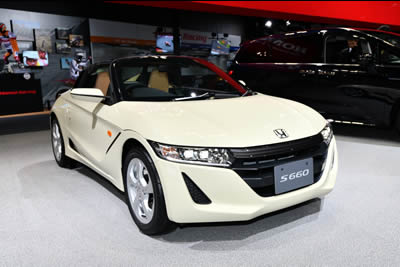 |
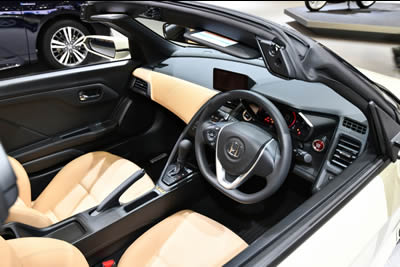 |
 |
|
| |
SUBARU S208
|
The Subaru S208 is the pinnacle complete model by STI (SUBARU TECNICA INTERNATIONAL). The engine designed to achieve a perfect balance of revolutions offers a flawless feel, and it reaches the highest power in the series (329 PS). Its unique power unit realizes sensual acceleration like never before. As you will notice the DNA of STI in the front racing bucket seats and the meshing front grill that tighten up the front face, its performance and quality meet at high dimension. This vehicle is for those who pursues ultimate driving and the owners will savor joy of possession. Limited production of 450 units. |
 |
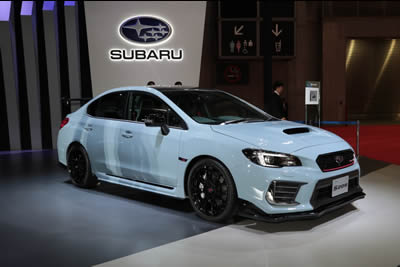 |
| |
SUBARU BRZ STI Sport |
Driving performance, style and quality - All of the STI's DNA are added to “SUBARU BRZ STI Sport”, the highest grade of SUBARU BRZ. It has polished up handling performance aiming for first-ever driving feeling that no one has ever had, so it provides you endless driving pleasure. Those excellent and high quality design of interior and exterior adds more value as well. The front mask gives us impression of keen eyes of athletes with dynamic artistic figure. The big 18-inch aluminum wheel tells its performance. The emblems of STI are shining at the front, on the fender and at the rear of the car. The chic and bold interior is finished in the color of bordeaux and black, and brings extreme pleasure to the owners. |
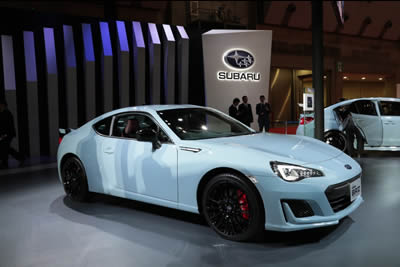 |
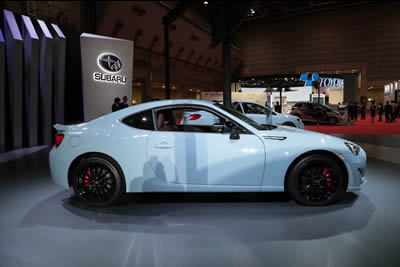 |
| |
MITSUBISHI ECLIPSE CROSS |
The Mitsubishi Eclipse Cross Japan market model makes its debut at Tokyo. It is a new-generation SUV that fuses sharp coupe looks with the dynamic SUV mobility.
The engine is a 1.5-liter downsizing turbo, providing as sense of acceleration with no sluggishness. The drivetrain includes Mitsubishi’s proprietary S-AWC which has an electronically-controlled 4WD system with brake activated AYC, providing precise handling and superior vehicle stability regardless of road surfaces, from ordinary to snow-covered roads.
The sharp and dynamic form maintains the DNA of reassurance and safety that runs through Mitsubishi Motors SUVs while adopting abundant unique styling. The exceptional comfort provides relaxation that completely overturns the impression received from the exterior.
Particular attention was paid to connectivity, and convenience and safety were pursued by incorporating various state-of-the-art devices.
|
| |
Mercedes Benz EQA Electric Concept |
The Mercedes-Benz Concept EQA demonstrates how the EQ strategy can be introduced to the compact class. Featuring one electric motor at the front axle and one at the rear, the electric athlete has a system output of over 200 kW.
Some Highligths of the Mercedes EQA Concept
All-electric and compact: The Concept EQA is Mercedes-Benz's first all-electric EQ concept vehicle in the compact segment.
Innovative light technology: When it comes to the lights, Mercedes-Benz has opted for laser fibres. The spiral-shaped light signet underlines the electric concept, its design evoking the copper windings of an electric motor and the animation visualising electrical impulses.
Powerful electric drive: Two electric motors, with a system output that can be increased to over 200 kW thanks to scalable battery components, and permanent all-wheel drive deliver impressive dynamic performance. The two drive programs offer a choice of individual drive characteristics.
Real-world range: In combination with the intelligent Mercedes-Benz operating strategy, the Concept EQA achieves a range of around 400 kilometres, depending on the battery capacity installed.
Convenient charging: The Concept EQA can be charged via induction or wallbox and is also ready for rapid charging. The vision for using public charging stations is "seamless charging": this Mercedes me-based service makes it easy for the customer to charge and pay at different charging stations.
Electric aesthetic: The Concept EQA is another example of the logical evolution of the Sensual Purity design idiom: sharp edges and lines have been significantly reduced. The black panel at the front acts as a virtual radiator grille whose look changes according to the drive program.
related article Mercedes Benz EQA Electric Concept 2017 |
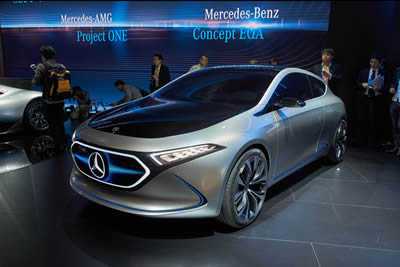 |
 |
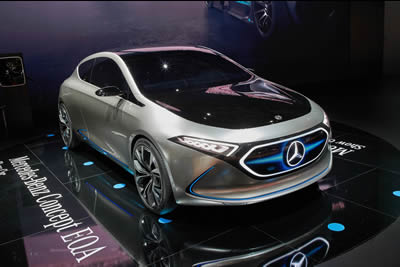 |
 |
| |
SMART Vision EQ Electric Autonomous Concept |
The smart vision EQ fortwo showcases a new solution for an individualised, highly flexible and efficient form of local public transport. The fully autonomous, electric-drive study presents a systematic concept for future urban mobility and the carsharing of the future. It picks up passengers directly at their preferred location and has neither steering wheel nor pedals. It is the first vehicle to embody all four elements of the company’s CASE strategy: “Connected”, “Autonomous”, “Shared” and “Electric”.
“The smart vision EQ fortwo has been rethought from the ground up, exclusively for comfortable transport from A to B in the city of the future. It is based on two principles that are actually mutually exclusive – sharing and personalisation. The passenger can pick someone else up along the way and share music, photos and the cost of the ride. That’s our idea of premium carsharing” says Dr. Dieter Zetsche. “To ensure you never have to wait long for a ride, the vehicles will travel in a swarm. Intelligent algorithms and artificial intelligence analyse usage patterns to ensure that the swarm moves at the right time to where vehicles will be needed.”
related article Smart Vision EQ Electric Autonomous Concept |
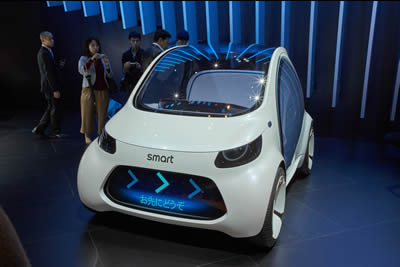 |
 |
|
| |
Paul Damiens, illustrations sources by Newspress, JAMA and manufacturers media archives |
|








